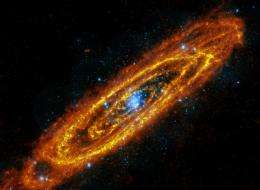The murmur of a monster

The Andromeda galaxy is the nearest large galaxy to our Milky Way. Like the Milky Way, it has a spiral-arm structure with a massive black hole at its nucleus. Unlike the Milky Way, however, its black hole is remarkable in size - about 30 times bigger than the one in our galaxy, or nearly one hundred million solar masses. It is also unusually passive: similar supermassive black holes in more distant galaxies are often surrounded by accretion disks that emit bright X-rays and generate powerful jets of charged particles. Andromeda lacks both.
Astronomers want to understand why the nucleus of Andromeda is so quiescent, both to model its black hole behavior, and also to try to understand why distant galactic nuclei are so different; did the Milky Way once pass through a similar phase?
The Milky Way's black hole is also quiescent compared to these other galaxies, but it is curious in that it does flare up occasionally at X-ray, infrared and radio wavelengths, sometimes increasing its brightness by a factor of ten or one hundred over short times. It had been thought that perhaps the Milky Way's black hole environment was different in a special way, perhaps somehow related to larger question of the extreme emission in distant systems.
CfA astronomers Zhiyuan Li, Michael Garcia, Bill Forman, Christine Jones, Ralph Kraft, Dharam Val, and Steve Murray carefully re-examined a decade's worth of Chandra X-ray Observatory observations of Andromeda, with a remarkable result. They found that although the nucleus was passive from 1999 until 2005, in 2006 it increased its X-ray luminosity by forty times, and remains bright and variable today. The team proposes future coordinated X-ray and radio studies. The results are important for showing that the Milky Way's black hole is not unique (at least in regard to flaring), and providing a step towards a better understanding of what goes on in other galactic nuclei with black holes.
Provided by Harvard-Smithsonian Center for Astrophysics











.jpg)








